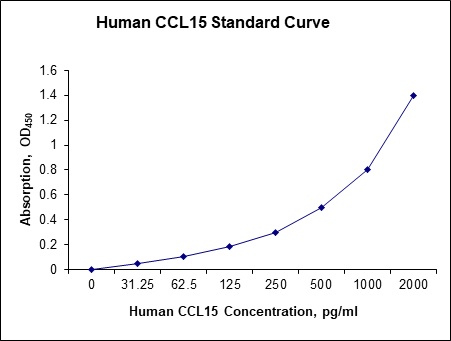Nori Human CCL15 ELISA Kit
$461.00 – $832.00
DataSheet CoA SDS
This ELISA kit is for quantification of CCL15 in dog. This is a quick ELISA assay that reduces time to 50% compared to the conventional method, and the entire assay only takes 3 hours. This assay employs the quantitative sandwich enzyme immunoassay technique and uses biotin-streptavidin chemistry to improve the performance of the assays. An antibody specific for CCL15 has been pre-coated onto a microplate. Standards and samples are pipetted into the wells and any CCL15 present is bound by the immobilized antibody. After washing away any unbound substances, a detection antibody specific for CCL15 is added to the wells. Following wash to remove any unbound antibody reagent, a detection reagent is added. After intensive wash a substrate solution is added to the wells and color develops in proportion to the amount of CCL15 bound in the initial step. The color development is stopped, and the intensity of the color is measured.
Alternative names for CCL15: Alternative names for CCL15: Chemokine (C-C motif) ligand 15, leukotactin-1, MIP5 and HCC-2
This product is for Laboratory Research Use Only not for diagnostic and therapeutic purposes or any other purposes.
- Description
- How Elisa Works
- Product Citations
- Reviews (0)
Description
Nori Human CCL15 ELISA Kit Summary
Alternative names for CCL15: Chemokine (C-C motif) ligand 15, leukotactin-1, MIP5 and HCC-2
| Assay Type | Solid Phase Sandwich ELISA |
| Format | 96-well Microplate or 96-Well Strip Microplate |
| Method of Detection | Colorimetric |
| Number of Targets Detected | 1 |
| Target Antigen Accession Number | Q16663 |
| Assay Length | 3 hours |
| Quantitative/Semiquantitative | Quantitative |
| Sample Type | Plasma, Serum, Cell Culture, Urine, Cell/Tissue Lysates, Synovial Fluid, BAL, |
| Recommended Sample Dilution (Plasma/Serum) | No dilution for sample <ULOQ; sufficient dilution for samples >ULOQ |
| Sensitivity | 6 pg/mL |
| Detection Range | 31.25-2000 pg/mL |
| Specificity | Natural and recombinant human CCK15 |
| Cross-Reactivity | < 0.5% cross-reactivity observed with available related molecules, < 50% cross-species reactivity observed with species tested. |
| Interference | No significant interference observed with available related molecules |
| Storage/Stability | 4 ºC for up to 6 months |
| Usage | For Laboratory Research Use Only. Not for diagnostic or therapeutic use. |
| Additional Notes | The kit allows for use in multiple experiments. |
Standard Curve
Kit Components
1. Pre-coated 96-well Microplate
2. Biotinylated Detection Antibody
3. Streptavidin-HRP Conjugate
4. Lyophilized Standards
5. TMB One-Step Substrate
6. Stop Solution
7. 20 x PBS
8. Assay Buffer
Other Materials Required but not Provided:
1. Microplate Reader capable of measuring absorption at 450 nm
2. Log-log graph paper or computer and software for ELISA data analysis
3. Precision pipettes (1-1000 µl)
4. Multi-channel pipettes (300 µl)
5. Distilled or deionized water
Protocol Outline
1. Prepare all reagents, samples and standards as instructed in the datasheet.
2. Add 100 µl of Standard or samples to each well and incubate 1 h at RT.
3. Add 100 µl of Working Detection Antibody to each well and incubate 1 h at RT.
4. Add 100 µl of Working Streptavidin-HRP to each well and incubate 20 min at RT.
5. Add 100 µl of Substrate to each well and incubate 5-30 min at RT.
6. Add 50 µl of Stop Solution to each well and read at 450 nm immediately.
Background:
Chemokine (C-C motif) ligand 15 (CCL15) is a small cytokine belonging to the CC chemokine family that is also known as leukotactin-1, MIP5 and HCC-2. CCL15 is expressed in liver, small intestine, colon, and in certain leukocytes and macrophages of the lung.[1] It is chemotactic for neutrophils, monocytes, and lymphocytes and elicits its effects by binding to cell surface chemokine receptors such as CCR1 and CCR3.[2][3] CCL15 is chemotactic for T cells and monocytes, and acts through C-C chemokine receptor type 1 (CCR1). The proprotein of CCL15 can be further processed into numerous smaller functional peptides. Compared with full-length CCL15, proteolytically processed CCL15 isoforms with N-terminal deletions display increased potency to induce calcium fluxes and chemotactic activity on monocytes and to induce adhesiveness of mononuclear cells to fibronectin.[4]
Matrix metalloproteinase can activate CCL15 [5] and quantum proteolytic activation of chemokine CCL15 by neutrophil granulocytes modulates mononuclear cell adhesiveness.[6] Plasma concentrations of CCL15 were elevated in a previously published cohort of 211 cGVHD patients compared with controls and associated with NRM.[7]
References
- Pardigol et al. (1998) Proc. Natl. Acad. Sci. 95: 6308-6313.
- Youn et al. (1997) J. Immun. 159: 5201-5205.
- Coulin et al. (1997) Europ. J. Biochem. 248: 507-515.
- Richter R, (2005) J. Immunol. 175 (3), 1599-1608.
- Starr AE, (2012) J. Biol. Chem. 287 (8), 5848-5860.
- Richter R, (2005) J. Immunol. 175 (3), 1599-1608.
- Du J, (2018)Blood 131 (15), 1743-1754.
Product Citations
Be the first to review “Nori Human CCL15 ELISA Kit”
You must be logged in to post a review.




























Reviews
There are no reviews yet.